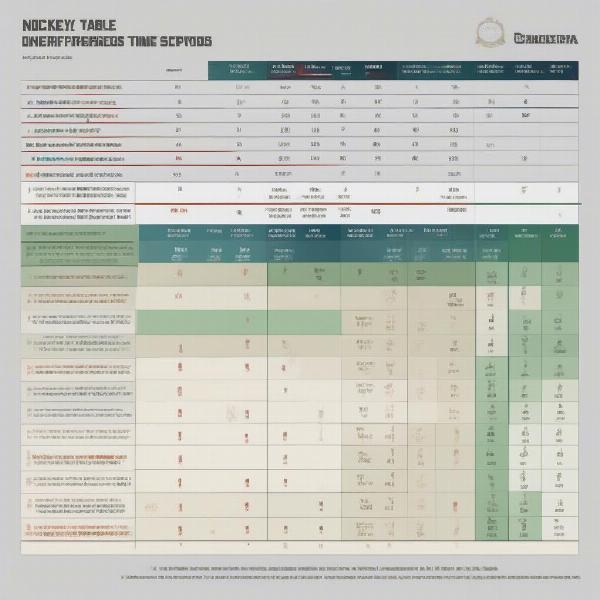Hockey, a sport known for its speed, skill, and intense physicality, often confuses newcomers with its unique time structure. So, How Many Quarters Are In A Hockey Game? The answer is surprisingly simple: zero. Hockey games aren’t divided into quarters. Instead, they are played in three periods. This is a crucial distinction for anyone new to the sport. Understanding this fundamental difference sets the stage for grasping the overall flow and excitement of a hockey match.
Many sports fans are familiar with the quarter system, common in basketball, American football, and even some forms of rugby. This naturally leads to the question of how hockey divides its game time. To clarify, a regulation professional hockey game is comprised of three 20-minute periods. These periods are separated by intermissions, offering players a chance to rest and strategize. This structure distinguishes hockey from other popular sports and contributes to its dynamic and fast-paced nature.
Understanding Hockey Game Structure
Why periods and not quarters? The history of hockey offers some clues. The game evolved on frozen ponds and lakes, and the early format reflected the natural breaks needed for players to warm up and recover. Three periods likely provided a balance between continuous play and necessary rest. This traditional format has endured, becoming a defining characteristic of the sport. For those accustomed to quarters, this might seem unusual. However, the three-period system creates a unique rhythm and intensity that hockey fans cherish.
Thinking of hockey time in terms of quarters is a common misconception. Many people associate the fast-paced, back-and-forth action with the shorter bursts of play seen in quarter-based sports. This is understandable, but ultimately inaccurate. The intensity of hockey stems from the constant flow of the game within each 20-minute period, punctuated by the strategic pauses of the intermissions. Understanding this nuance is key to appreciating the sport’s strategic depth. If a game is tied after regulation, overtime is played. This overtime period varies depending on the league and the stage of the season, further adding to the complexity of hockey’s timekeeping.
How long is a hockey game, then? While regulation time is 60 minutes (three 20-minute periods), the actual time from start to finish can be much longer. Factors such as stoppages, penalties, and intermissions contribute to the overall length. This is a key difference compared to sports like basketball, where the clock often stops. You can learn more about the length of a professional hockey game by visiting this insightful article: how long is a professional hockey game. The ebb and flow of the game, with its bursts of speed and strategic pauses, contribute to hockey’s captivating nature.
Why the Confusion Around Quarters?
The prevalence of quarters in other popular sports likely contributes to the confusion. People often apply their existing knowledge of sports timing to hockey, assuming a similar structure. This is a natural cognitive process, but it’s important to recognize the unique characteristics of each sport. Understanding the specific terminology and rules of hockey enhances the viewing experience.
Another potential source of confusion comes from youth hockey leagues. Some youth leagues, aiming to make the game more accessible and manageable for younger players, may use shorter periods or even a quarter system. This variation at the youth level can sometimes lead to misunderstandings about the standard structure of a professional hockey game. It’s essential to distinguish between the adapted rules of youth leagues and the official regulations governing professional play. This distinction clarifies the true nature of how hockey games are timed at the highest levels of competition. Similar to how soccer is divided into halves, not quarters, as discussed in this article: how many quarters in soccer game, hockey has its own distinct time structure.
 Hockey Periods vs Quarters Comparison
Hockey Periods vs Quarters Comparison
Periods, Intermissions, and Overtime: A Detailed Look
Each 20-minute period in hockey is a self-contained battle, full of strategic adjustments and momentum swings. Teams adapt their play based on the score, the opponent’s tactics, and the physical condition of their players. This dynamic creates a compelling narrative within each period, adding layers of excitement to the overall game. The intermissions between periods offer crucial opportunities for teams to regroup, analyze their performance, and plan for the next stage of the game.
Understanding how many periods are in a hockey game is fundamental to appreciating the sport’s unique flow. You can delve deeper into this topic in our informative article: how many periods in a hockey game. These breaks are essential for player recovery and coaching adjustments, influencing the outcome of the match. The strategic use of intermission time often determines which team gains the upper hand in the subsequent period.
If a game is tied after regulation, an overtime period is played. The length and format of overtime vary depending on the league and the context of the game (regular season vs. playoffs). Overtime adds another layer of drama and intensity, often leading to sudden-death victories and unforgettable moments. This sudden-death element injects a thrilling unpredictability into the game, making it even more captivating for spectators.
Related Aspects of Hockey Timing
Understanding the division of time in a hockey game is just one piece of the puzzle. Other related aspects, such as penalties, power plays, and stoppage time, contribute to the overall flow and strategy of the game. These elements add complexity and nuance to hockey, making it a sport that rewards both skillful play and tactical awareness. Penalties, for example, can dramatically shift the momentum of a game, creating opportunities for power plays and potentially influencing the final score.
Conclusion
So, how many quarters are in a hockey game? The answer remains zero. Hockey uses a three-period system, a distinct feature that contributes to the sport’s unique rhythm and intensity. Understanding this fundamental difference is essential for anyone seeking to appreciate the nuances of hockey. From the fast-paced action within each period to the strategic breaks of intermissions and the potential drama of overtime, the timing of a hockey game is an integral part of its captivating nature. Now that you know the answer, you’re better equipped to follow the action and enjoy the thrill of this dynamic sport.
FAQ
-
How long is each period in a professional hockey game? Each period is 20 minutes long.
-
What happens if the game is tied after three periods? An overtime period is played.
-
Are there quarters in youth hockey leagues? Some youth leagues may use shorter periods or a quarter system.
-
Why doesn’t hockey use quarters like basketball or football? The three-period system is a historical tradition and contributes to the unique flow of the game.
-
How long are intermissions in hockey? Intermissions are typically 15-20 minutes long.
-
What is sudden-death overtime in hockey? It means the first team to score in overtime wins the game.
-
How does knowing about periods instead of quarters help me understand hockey better? It helps you follow the flow of the game, appreciate the strategic use of intermissions, and understand the impact of overtime.

